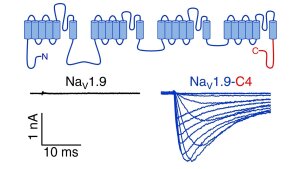Functional expression of Nav1.9 chimeras
Representative current traces measured in the whole-cell mode in response to depolarizations ranging from -127 to 3 mV of HEK 293T cells expressing human NaV1.9 (left) or chimera NaV1.9-C4 (right).
Illustration: FSU BiophysikVoltage-gated sodium channel NaV1.9 is expressed in nociceptive neurons and thus plays an important role in the processing of neuronal signals leading to the sensation of pain. However, systematic investigations of NaV1.9 in isolation have been hampered because of unsuccessful expression in non-neuronal host cells. Here we show that a chimera of NaV1.9, harboring the C-terminal domain of skeletal muscle NaV1.4, yields functional channels when expressed in Xenopus oocytes and HEK 293T cells. This chimera largely conserves the functional properties of NaV1.9 as far as channel activation and pore pharmacology are concerned, thus providing a model system for research on NaV1.9 channels.
